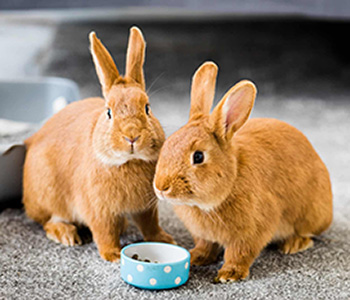It’s baby bunny season! From now until fall, rabbits will be breeding. And they tend to put their nests in dangerous locations. It is very common for rabbit nests to be found in the middle of a lawn or even in a fire pit. Here’s some information to help you protect these adorable little babies.
First, It’s important to note that finding a nest of baby bunnies without their mom is completely normal. Mother rabbits don’t stay on their nest. Instead, they visit a couple times a day to nurse the babies and then move away from the nest. If you think the nest is abandoned, please call us for guidance. We can help you determine if mom is still caring for the babies.
Next, it’s important to know that baby bunnies leave the nest and are self reliant at a surprisingly young age, usually by 3 weeks old. If you find a healthy looking baby rabbit that is around the size of a softball, fully furred with open eyes and upright ears, it likely does not need intervention. If you aren’t sure if a bunny is ready to be on its own, please call us and/or send us a photo and we can help.
Here are some ways YOU can help protect baby bunnies in your yard:
*Check your yard before mowing or weed whacking* We get a lot of baby bunnies whose nests were accidentally run over by lawnmowers or weed whackers. Rabbits do not dig burrows. Instead, nests are made in shallow depressions and then covered with grass. Look for areas of flatter grass and/or dry patches, as well as grass patches that are strangely shaped or angled.
*Keep pets away from nests* A large portion of the rabbits we receive are due to cats and dogs gaining access to bunny nests. Inspect your yard for nests before letting pets outside. Consider keeping your dogs leashed. Keep cats indoors when possible. If you find a nest, make sure your pets cannot access it. You can call us for more advice on protecting known nests.
*Check fireplaces and brush piles before burning* We tend to receive a few baby bunnies each year with burn injuries. Check fireplaces and brush piles carefully before starting fires. Occasionally rabbits will utilize these areas for nesting. Any wood or brush that has been sitting unattended should be moved to another area to check for bunny nests (and other animals) before burning.
*Do not kidnap healthy babies* Before removing bunnies from the wild, make sure they actually need help. Signs that a baby bunny DOES likely need help are: any known physical contact with a cat or dog, visible injuries, cold to the touch (touching the babies will NOT keep mom from returning), visibly wet, crying, laying on their side, maggots or fly eggs (fly eggs look like grains of rice and are often clustered), or obvious malnourishment. If you’re not sure if a bunny (or any other animal) needs help, please call us. We are happy to help you determine if help is needed.
This article was posted on Centre Wildlife Care's Facebook page.
 BUNNIES, ETC.
BUNNIES, ETC.


 About Us
About Us Adoptions
Adoptions Lost & Found
Lost & Found Short On Luck
Short On Luck
 Bunnies, Etc.
Bunnies, Etc. New Beginnings
New Beginnings Petunia Says...
Petunia Says... MYTH 1: Rabbits are great, low-maintenance starter pets.
MYTH 1: Rabbits are great, low-maintenance starter pets. 